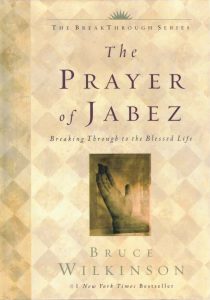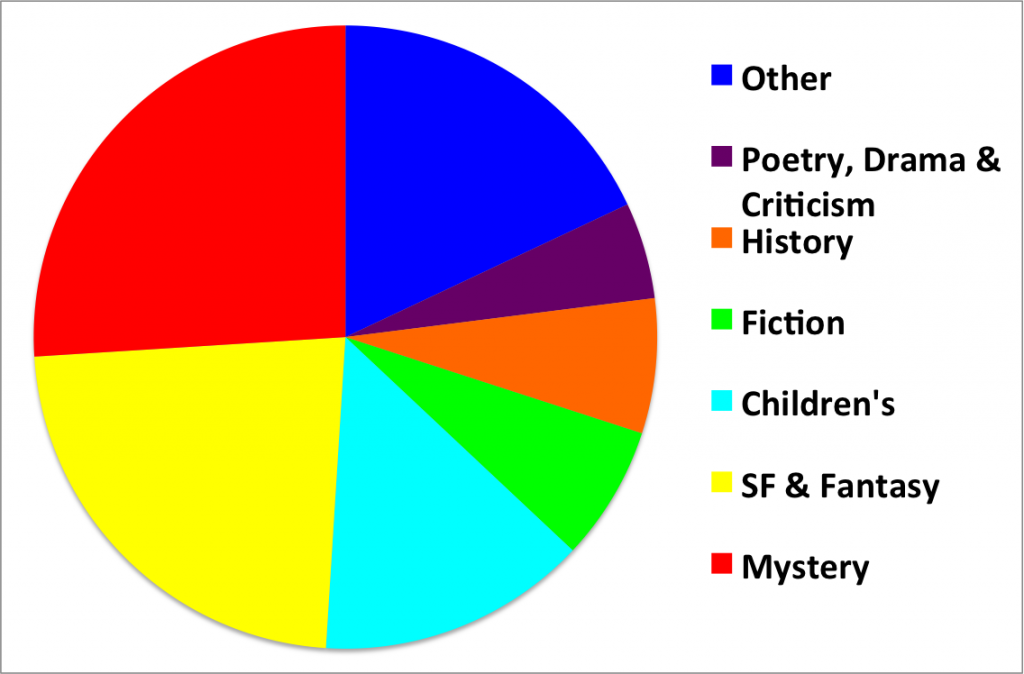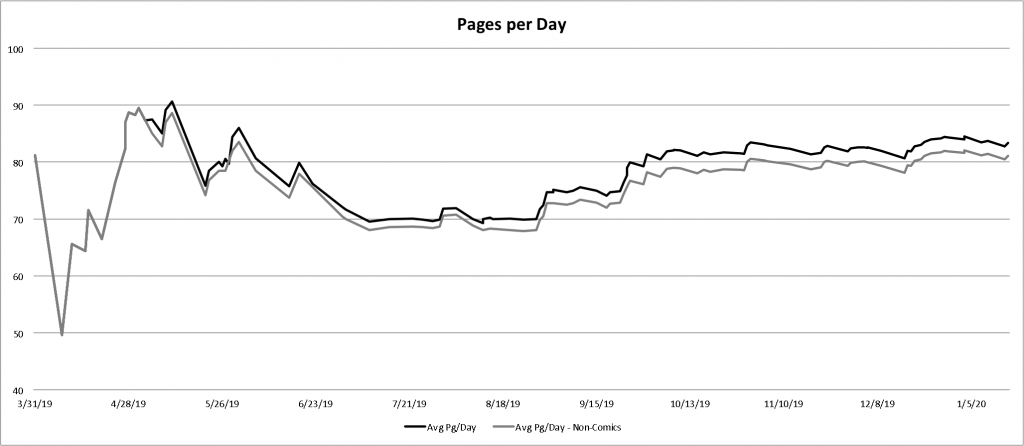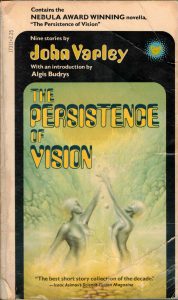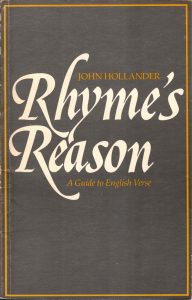or, At Least The Unexamined Life Requires Less Math
As I mentioned a little while back, I have now read 400 of the books in my personal library since I started tracking my reading back in June 2015. Below is a sketchy analysis of the books in this last hundred books. Of course, as usual, I have not counted books in the “Comics & Graphic Novel” category from the count, though some data from the ten books in that genre that I read over the course of the books covered here do appear at times below.
I continued the fast reading pace I attained during the last century of books read, dropping only slightly from 2.79 to 2.97 days per book. (You math geniuses out there have already figured out that I read the last hundred books in 297 days.) The 6.5% increase in days per book read was overshadowed, however, by the roughly 8% or 10% drop in pages read per day. (The discrepancy here is the difference between total pages read versus only those non-comics pages read.) While the previous century of books saw a blistering pace of over 90 pages read per day, this particular set of a hundred books saw a page rate of 83.08 pages read per day—or 80.8 pages per day if we only count the non-comics. We’ll come back to a consideration of pages per day a little later, if that’s all right with you.
1 Book Read per 2.97 Days
Looking further at the books per day statistic, the speedy rate dropped further the total reading rate for the entire set of four hundred books. That total rate—which had been 4.60 at last report, dropped even further to 4.18 days per book read. If we include Comics & Graphic Novels, the rate goes down to only 3.70 days per book. (It had been just a smidge over 4 last time we checked.) Below is a chart showing the overall pace for each hundred books read, as well as the totals. (For those of y’all playing along at home, the timespan between the first and last books read is 1,675 days.)
Average Time to Read a Book
non-Comics All 1st hundred 4.83 3.63 2nd hundred 6.19 5.79 3rd hundred 2.79 2.74 4th hundred 2.97 2.70 All 4.18 3.70
This focus on book reading rate continues from my initial scratchpad calculation that I wouldn’t finish reading all of my book until Pearl Harbor Day in 2124. A more detailed analysis after the 300th book read brought that end date somewhat closer, to April 9, 2108. However, as I pointed out in the same article, the time to completion is complicated by the fact that I am still buying books; in fact, as that post noted, my book purchase rate is greater than my book reading rate. *Sigh* We’ll just set that issue aside for right now, though, and instead look again at the calculated time to completion with the latest information. Another quick calculation—this time taking over four hours (not including the several hours needed for my database dumps to work correctly)—gives me the figure of 8363 books unread at the moment. (This actually compares fairly favorably to my back-of-the-envelope reckoning of 9472 books owned, ignoring duplicates, which means I’ve read just over 1/8 of my collection—not too bad, actually.) Using the newly computed book reading rate of 3.7 days per book gives me an EFD (Estimated Finish Date) a trifle nearer in time than last report, though still in the next century. Specifically:
Reading Rate: 1 Book per 3.70 Days (includes Comics)
Time to Finish Collection: 84 & 3/4 Years
Estimated Finish Date (EFD): October 24, 2104
Unfortunately, all of the gains made towards bringing down my Time to Completion seem to have come from the breakneck pace of reading, and are in spite of incontinent book buying. Indeed, during the same time I read 110 books (including the 10 comic books and graphic novels), I seem to have acquired 438 new never-before-read volumes. This is obviously troubling, and even more than first appears due to the calculation made in that previous analysis of how long it will take me to read all of my books. There I came around to the following equation, defining how long will take to finish reading my library:
(2.3) ![]()
Formula ![]() simply says that the time
simply says that the time ![]() required to finish reading my library is equal to the initial number of books
required to finish reading my library is equal to the initial number of books ![]() divided by the net consumption rate of books, which is the Reading Rate
divided by the net consumption rate of books, which is the Reading Rate ![]() less the Purchase Rate
less the Purchase Rate ![]() . As I noted in that earlier post, as long as the Reading Rate is greater than the Purchase Rate, I will eventually finish the collection.
. As I noted in that earlier post, as long as the Reading Rate is greater than the Purchase Rate, I will eventually finish the collection.
At 300 books, ![]() was equal to 0.25 and
was equal to 0.25 and ![]() was roughly 1.01. At 400 books read, however,
was roughly 1.01. At 400 books read, however, ![]() has only risen two hundredths to 0.27 while
has only risen two hundredths to 0.27 while ![]() is now a whopping 1.47 books acquired per day. (I say ‘acquired’ because this last few months saw a number of books given me by my father, who moved to Texas and pruned many things (not just books) before his move. I do not include the many, many, many copies of Ayn Rand’s Anthem that we were terrorized with at the end of the year and with which I still have not figured out what to do.) If these figures are used, and assuming
is now a whopping 1.47 books acquired per day. (I say ‘acquired’ because this last few months saw a number of books given me by my father, who moved to Texas and pruned many things (not just books) before his move. I do not include the many, many, many copies of Ayn Rand’s Anthem that we were terrorized with at the end of the year and with which I still have not figured out what to do.) If these figures are used, and assuming ![]() is equal to 8363, we find that I lost my chance to complete my collection at the very end of the year 2000—but then, didn’t we all? Of course, as you’ve no doubt already noticed, this last number uses an overall figure for the Reading Rate
is equal to 8363, we find that I lost my chance to complete my collection at the very end of the year 2000—but then, didn’t we all? Of course, as you’ve no doubt already noticed, this last number uses an overall figure for the Reading Rate ![]() while the Purchase Rate
while the Purchase Rate ![]() is only that for the last 100 books, so I’ve cheated a bit; but I’ve done so only to emphasize the very great, very real danger of the current situation. And oh yeah also because it’s kind of hard to calculate
is only that for the last 100 books, so I’ve cheated a bit; but I’ve done so only to emphasize the very great, very real danger of the current situation. And oh yeah also because it’s kind of hard to calculate ![]() without getting into some Calculus. What? *Sigh* Okay. Give me a sec.
without getting into some Calculus. What? *Sigh* Okay. Give me a sec.
You know what? Never mind. Instead of looking at the actual curve of the Purchase Rate—which is what I really need to do to see what’s actually going on in that department—we’ll just take the Purchase Rate for the entire time I’ve been tracking books read in my database (=1.12) and use the more accurate figure of 6466 books for ![]() (this is the number of books in my database when I started the aforementioned tracking), which gives us a value for
(this is the number of books in my database when I started the aforementioned tracking), which gives us a value for ![]() equal to … -7,607 days, or in other words … April 1, 1999. April Fool’s Day, eh? Well, that seems appropriate. That is, I missed my opportunity to complete this project on a date two months after the verdict in Bill Clinton’s impeachment trial. After all, didn’t we all? No, seriously though, this calculation means that—given the rates above—I could have only read all of my books at a time some sixteen years before I started reading my books. Yeah, I know. Math is weird.
equal to … -7,607 days, or in other words … April 1, 1999. April Fool’s Day, eh? Well, that seems appropriate. That is, I missed my opportunity to complete this project on a date two months after the verdict in Bill Clinton’s impeachment trial. After all, didn’t we all? No, seriously though, this calculation means that—given the rates above—I could have only read all of my books at a time some sixteen years before I started reading my books. Yeah, I know. Math is weird.
In part, the desire to increase my reading rate has driven me to read some shorter volumes (though surprisingly the total pages read for this hundred books was only slightly less than the total for the previous hundred, as we shall see), which rationale might be thought to be behind my high number of children’s books read. In fact, however, the books in the Children’s category were read primarily because a) I only recently regained access to those books, and b) the books chosen leant themselves to double shelving and thus space saving on the shelves. An impetus related to that last drove also some of the lesser books read over this last slice, as I sought books I could let go of, thus also relieving somewhat my overburdened shelf space. This last endeavor, however, has proven to be difficult, in part because my reading rate suffers when I read most of the less well-written books, but mostly because it’s a pain in the ass. Looking at the figures above may impel me to take a course of action I have been resisting: to simply throw away (appropriately, natch) books that look ‘bad’, without reading them first. My heart aches at the idea, and my brain sighs at yet another datapoint I’ll need to capture or manipulate for this project. But the current hardship I have slogging through The Spirituality of Imperfection (which I would call instead The Banality of Feeble) or a book warning of the dangers of wealth concentration from 2001 may make such action inevitable.
With these caveats and explanations out of the way, let’s turn to the books I actually read in this last set of a hundred books. The full list can be found broken up into bite-sized chunks of 25 books each here, here, here, and … here. Genre fiction did not overwhelmingly predominate as it did in the previous hundred, though Mysteries and SF/Fantasy do represent almost half of the books read. Children’s books make up 14% of the total, while Nonfiction books were three-tenths of the hundred (non-comics) books read—lumping plays and poetry into the ‘Nonfiction’ category. Here’s the overall break down:
Books Read by Genre
Mystery & Thriller 26 Science Fiction & Fantasy 23 Children’s Books 14 Literature & Fiction 7 History 7 Poetry, Drama & Criticism 5 Other 18
And of course there is a chart
The breakdown of the two-and-a-half dozen Nonfiction books (ignoring Children’s books) is as follows:
History 7 Poetry, Drama & Criticism 5 Wacko 4 Computers & Internet 2 Militaria 2 Politics & Social Sciences 2 Religion & Spirituality 2 Arts & Photography 1 Books 1 D&D 1 End of the World 1 Outdoors & Nature 1 Reference 1
Continuing the analysis of page counts begun in the review of the previous century of books read, we find that I slowed my reading pace somewhat from last report. Though I began the 4th hundred books read at a speedy clip, I slowed a bit during the summer months, returning to form since October. Below is a chart showing the cumulative pages read over the last hundred books, to which I’ve added a linear trendline with which to more easily see the summer slump.
Reviewing the books I read during these sluggard months, I am not entirely sure why my pace slackened (though it still is much faster than the 34.4 pages per day I maintained while reading books #101 – #200). There are a few suggestive items, however. First, this slowdown begins just as I read my first (and so far only) ebook, a turn-of-the-century-before-the-last-one Norwegian mystery novel I had been unable to find in physical format. (It’s okay, I suppose.) I don’t have a mechanism for calculating page counts of ebooks, so it is simply a blank in the data. Second, this period also saw me read some books I had very little love for, including some works of the lesser Brontë sisters, the desultory mysteries of Amanda Cross, and some William Gibson short stories that weren’t as good as I remembered. This lack of interest may have lowered my attentiveness and thus my reading rate.
The dip in reading velocity can be seen in this chart depicting exactly that:
As is usual with such a chart, there’s a lot of noise at the beginning before the average rate begins to assert itself. This could, of course, be abated somewhat by considering a longer time span, by beginning the time period back when I began tracking pages read, but … let’s just wait until I’ve hit 500 books read, shall we?
The overall reading pace for the last hundred books clocks in at just over 83 pages per day, a significant decline from the 90 pgs/day over the previous hundred, but quite respectable for all that.
83.08 Pages Read per Day
Since I read 10 items from the Comics & Graphic Novels category, the above figure drops somewhat when those comics are excluded from the calculation. (I use the total books read for the generally promulgated Pages/Day rate, since the small page count of most comic books is reflected in this stat, whereas it is not in the Days per Book statistic.) Exempting those books gives a slightly lower page per day rate of 80.8 pages per day. Do not forget, however, that this figure reflects not just the fact that some non-comics pages may take longer to read, but also the fact that time spent reading comics is time not being used to read non-illustrated prose. The lower reading pace for non-comics is shown by the grey line in the figure above.
Once again rotating some axes, we find that the page count per book dropped 4% from last report, from 250 to 240 pages per book. If comics are included in this figure, the average becomes 224.3 pages per book (as opposed to 246.5 for this same datapoint from the last series).
Average Book Length: 239.98 Pages
The total number of pages clocked in at just below 25k, at 24,675. With comics etc. removed, we find that 23,998 pages were consumed in this last tranche of books. (Which of course means that, since I read 10 comics etc., that the average length for those excluded books was 67.7 pages.)
Total Pages Read (non comics): 23,998
The average rating dropped a bit from last report, falling from 3.94 to 3.79. Not too surprising, as I have been reading books that appear to be potential candidates for culling. There were many average books in this last set, and several that were worse than average. A slight surprise is found in the average rating for all books in the last set, including those in the Comics & Graphic Novels category, as a few ‘meh’ comics and one turkey brought down the overall rating slightly to 3.77. The delta between non-comics rating and total rating was reversed in the last set.
Average Rating for Books Read: 3.79
I am not entirely sure of my reading strategy for the next century, though I am tempted just to fly pell-mell through some of the many Mystery paperbacks that have been tempting me for quite a while. A return to Kregen and the life of Dray Prescot also seems appealing. Since completing book #400, I’ve read 4 novels and 1 business book, so there’s that.
I shall be back in a few days, with a belated look at the Best Books of 2019. (I’ll add the hyperlink here once that’s completed.) See ya!






